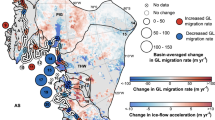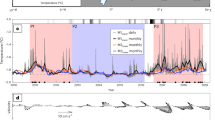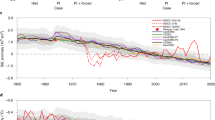Abstract
Recent ice loss from the West Antarctic Ice Sheet has been caused by ocean melting of ice shelves in the Amundsen Sea. Eastward wind anomalies at the shelf break enhance the import of warm Circumpolar Deep Water onto the Amundsen Sea continental shelf, which creates transient melting anomalies with an approximately decadal period. No anthropogenic influence on this process has been established. Here, we combine observations and climate model simulations to suggest that increased greenhouse gas forcing caused shelf-break winds to transition from mean easterlies in the 1920s to the near-zero mean zonal winds of the present day. Strong internal climate variability, primarily linked to the tropical Pacific, is superimposed on this forced trend. We infer that the Amundsen Sea experienced decadal ocean variability throughout the twentieth century, with warm anomalies gradually becoming more prevalent, offering a credible explanation for the ongoing ice loss. Existing climate model projections show that strong future greenhouse gas forcing creates persistent mean westerly shelf-break winds by 2100, suggesting a further enhancement of warm ocean anomalies. These wind changes are weaker under a scenario in which greenhouse gas concentrations are stabilized.
This is a preview of subscription content, access via your institution
Access options
Access Nature and 54 other Nature Portfolio journals
Get Nature+, our best-value online-access subscription
$29.99 / 30 days
cancel any time
Subscribe to this journal
Receive 12 print issues and online access
$259.00 per year
only $21.58 per issue
Buy this article
- Purchase on Springer Link
- Instant access to full article PDF
Prices may be subject to local taxes which are calculated during checkout





Similar content being viewed by others
Data availability
Sea-ice concentration and drift data that support the findings of this study are available from the National Snow and Ice Data Center (https://doi.org/10.5067/8GQ8LZQVL0VL and https://doi.org/10.5067/O57VAIT2AYYY, respectively). ERA-Interim reanalysis data are available from the ECMWF (https://apps.ecmwf.int/datasets/data/interim-full-daily). Extended Reconstructed Sea Surface Temperature data are available from the National Oceanic and Atmospheric Administration National Climatic Data Center (https://www.ncdc.noaa.gov/data-access/marineocean-data/extended-reconstructed-sea-surface-temperature-ersst-v5). Seabed data are available from the British Antarctic Survey (https://secure.antarctica.ac.uk/data/bedmap2). Climate indices are available from the National Oceanic and Atmospheric Administration Earth System Research Laboratory (https://www.esrl.noaa.gov/psd/data/climateindices/list). CMIP5 simulation data are available from the Centre for Environmental Data Analysis (http://www.ceda.ac.uk). CESM simulation data are available from the National Center for Atmospheric Research Climate Data Gateway (https://www.earthsystemgrid.org).
Code availability
The Matlab scripts used for the analyses described in this study can be obtained from the corresponding author on reasonable request.
References
Shepherd, A. et al. Mass balance of the Antarctic Ice Sheet from 1992 to 2017. Nature 558, 219–222 (2018).
Shepherd, A., Wingham, D. & Rignot, E. Warm ocean is eroding West Antarctic Ice Sheet. Geophys. Res. Lett. 31, L23402 (2004).
Mouginot, J., Rignot, E. & Scheuchl, B. Sustained increase in ice discharge from the Amundsen Sea Embayment, West Antarctica, from 1973 to 2013. Geophys. Res. Lett. 41, 1576–1584 (2014).
Konrad, H. et al. Uneven onset and pace of ice-dynamical imbalance in the Amundsen Sea Embayment, West Antarctica. Geophys. Res. Lett. 44, 910–918 (2017).
Jenkins, A. et al. Decadal ocean forcing and Antarctic Ice Sheet response: lessons from the Amundsen Sea. Oceanography 29, 106–117 (2016).
Jenkins, A. et al. West Antarctic Ice Sheet retreat in the Amundsen Sea driven by decadal oceanic variability. Nat. Geosci. 11, 733–738 (2018).
Snow, K. et al. The response of ice sheets to climate variability. Geophys. Res. Lett. 44, 11878–11885 (2017).
Jenkins, A. et al. Observations beneath Pine Island Glacier in West Antarctica and implications for its retreat. Nat. Geosci. 3, 468–472 (2010).
Steig, E. J., Ding, Q., Battisti, D. S. & Jenkins, A. Tropical forcing of Circumpolar Deep Water inflow and outlet glacier thinning in the Amundsen Sea Embayment, West Antarctica. Ann. Glaciol. 53, 19–28 (2012).
De Rydt, J., Holland, P. R., Dutrieux, P. & Jenkins, A. Geometric and oceanographic controls on melting beneath Pine Island Glacier. J. Geophys .Res. Oceans 119, 2420–2438 (2014).
De Rydt, J. & Gudmundsson, G. H. Coupled ice shelf–ocean modeling and complex grounding line retreat from a seabed ridge. J. Geophys. Res. Earth Surf. 121, 865–880 (2016).
Smith, J. A. et al. Sub-ice-shelf sediments record history of twentieth-century retreat of Pine Island Glacier. Nature 541, 77–80 (2016).
Jacobs, S. S., Hellmer, H. H. & Jenkins, A. Antarctic Ice Sheet melting in the Southeast Pacific. Geophys. Res. Lett. 23, 957–960 (1996).
Dutrieux, P. et al. Strong sensitivity of Pine Island ice-shelf melting to climatic variability. Science 343, 174–178 (2014).
Thoma, M., Jenkins, A., Holland, D. & Jacobs, S. Modelling Circumpolar Deep Water intrusions on the Amundsen Sea continental shelf, Antarctica. Geophys. Res. Lett. 35, L18602 (2008).
Kimura, S. et al. Oceanographic controls on the variability of ice-shelf basal melting and circulation of glacial meltwater in the Amundsen Sea Embayment, Antarctica. J. Geophys. Res. Oceans 122, 10131–10155 (2017).
Webber, B. G. M., Heywood, K. J., Stevens, D. P. & Assmann, K. M. The impact of overturning and horizontal circulation in Pine Island Trough on ice shelf melt in the Eastern Amundsen Sea. J. Phys. Oceanogr. 49, 63–83 (2019).
Assmann, K. M. et al. Variability of Circumpolar Deep Water transport onto the Amundsen Sea continental shelf through a shelf break trough. J. Geophys. Res. Oceans 118, 6603–6620 (2013).
Walker, D. P., Jenkins, A., Assmann, K. M., Shoosmith, D. R. & Brandon, M. A. Oceanographic observations at the shelf break of the Amundsen Sea, Antarctica. J. Geophys. Res. Oceans 118, 2906–2918 (2013).
St-Laurent, P., Klinck, J. M. & Dinniman, M. S. Impact of local winter cooling on the melt of Pine Island Glacier, Antarctica. J. Geophys. Res. Oceans 120, 6718–6732 (2015).
Davis, P. E. D. et al. Variability in basal melting beneath Pine Island Ice Shelf on weekly to monthly timescales. J. Geophys. Res. Oceans 123, 8655–8669 (2018).
Webber, B. G. M. et al. Mechanisms driving variability in the ocean forcing of Pine Island Glacier. Nat. Commun. 8, 14507 (2017).
Kim, T. W. et al. Is Ekman pumping responsible for the seasonal variation of warm Circumpolar Deep Water in the Amundsen Sea? Cont. Shelf Res. 132, 38–48 (2017).
Raphael, M. N. et al. The Amundsen Sea Low: variability, change, and impact on Antarctic climate. Bull. Am. Meteorol. Soc. 97, 111–121 (2016).
Lachlan-Cope, T. & Connolley, W. Teleconnections between the tropical Pacific and the Amundsen–Bellinghausens Sea: role of the El Niño/Southern Oscillation. J. Geophys. Res. Atmos. 111, D23101 (2006).
Deser, C., Alexander, M. A., Xie, S. P. & Phillips, A. S. Sea surface temperature variability: patterns and mechanisms. Annu. Rev. Mar. Sci. 2, 115–143 (2010).
Schneider, D. P. & Deser, C. Tropically driven and externally forced patterns of Antarctic sea ice change: reconciling observed and modeled trends. Clim. Dyn. 50, 4599–4618 (2018).
Steig, E. J. et al. Recent climate and ice-sheet changes in West Antarctica compared with the past 2,000 years. Nat. Geosci. 6, 372–375 (2013).
Schneider, D. P. & Steig, E. J. Ice cores record significant 1940s Antarctic warmth related to tropical climate variability. Proc. Natl Acad. Sci. USA 105, 12154–12158 (2008).
Kay, J. E. et al. The Community Earth System Model (CESM) Large Ensemble Project: a community resource for studying climate change in the presence of internal climate variability. Bull. Am. Meteorol. Soc. 96, 1333–1349 (2015).
Bracegirdle, T. J., Turner, J., Hosking, J. S. & Phillips, T. Sources of uncertainty in projections of 21st century westerly wind changes over the Amundsen Sea, West Antarctica, in CMIP5 climate models. Clim. Dyn. 43, 2093–2104 (2014).
Harvey, B. J., Shaffrey, L. C. & Woollings, T. J. Equator-to-pole temperature differences and the extra-tropical storm track responses of the CMIP5 climate models. Clim. Dyn. 43, 1171–1182 (2014).
Arblaster, J. M. & Meehl, G. A. Contributions of external forcings to southern annular mode trends. J. Clim. 19, 2896–2905 (2006).
Schneider, D. P., Deser, C. & Fan, T. T. Comparing the impacts of tropical SST variability and polar stratospheric ozone loss on the Southern Ocean westerly winds. J. Clim. 28, 9350–9372 (2015).
Gillett, N. P., Fyfe, J. C. & Parker, D. E. Attribution of observed sea level pressure trends to greenhouse gas, aerosol, and ozone changes. Geophys. Res. Lett. 40, 2302–2306 (2013).
Yeh, S. W. et al. ENSO atmospheric teleconnections and their response to greenhouse gas forcing. Rev. Geophys. 56, 185–206 (2018).
Cai, W. J. et al. ENSO and greenhouse warming. Nat. Clim. Change 5, 849–859 (2015).
Christianson, K. et al. Sensitivity of Pine Island Glacier to observed ocean forcing. Geophys. Res. Lett. 43, 10817–10825 (2016).
Rignot, E., Jacobs, S., Mouginot, J. & Scheuchl, B. Ice-shelf melting around Antarctica. Science 341, 266–270 (2013).
Barnes, E. A., Barnes, N. W. & Polvani, L. M. Delayed Southern Hemisphere climate change induced by stratospheric ozone recovery, as projected by the CMIP5 models. J. Clim. 27, 852–867 (2014).
Sanderson, B. M., Oleson, K. W., Strand, W. G., Lehner, F. & O’Neill, B. C. A new ensemble of GCM simulations to assess avoided impacts in a climate mitigation scenario. Climatic Change 146, 303–318 (2018).
Little, C. M. & Urban, N. M. CMIP5 temperature biases and 21st century warming around the Antarctic coast. Ann. Glaciol. 57, 69–78 (2016).
Cavalieri, D. J., Parkinson, C. L., Gloersen, P. & Zwally, H. J. Sea Ice Concentrations from Nimbus-7 SMMR and DMSP SSM/I-SSMIS Passive Microwave Data, Version 1. 1992–2016 (National Snow and Ice Data Center, 1996); https://doi.org/10.5067/8GQ8LZQVL0VL
Tschudi, M., Fowler, C., Maslanik, J., Stewart, J. S. & Meier, W. Polar Pathfinder Daily 25km EASE-Grid Sea Ice Motion Vectors, Version 3. 1992–2016 (National Snow and Ice Data Center, 2016); https://doi.org/10.5067/O57VAIT2AYYY
Dee, D. P. et al. The ERA-Interim reanalysis: configuration and performance of the data assimilation system. Q. J. R. Meteorol. Soc. 137, 553–597 (2011).
Fretwell, P. et al. Bedmap2: improved ice bed, surface and thickness datasets for Antarctica. Cryosphere 7, 375–393 (2013).
Huang, B. et al. NOAA Extended Reconstructed Sea Surface Temperature (ERSST). Version 5. 1854–2016 (NOAA National Centers for Environmental Information, 2017); https://www.ncdc.noaa.gov/data-access/marineocean-data/extended-reconstructed-sea-surface-temperature-ersst-v5
Crosby, D. S., Breaker, L. C. & Gemmill, W. H. A proposed definition for vector correlation in geophysics—theory and application. J. Atmos. Ocean. Technol. 10, 355–367 (1993).
Kim, C. S. et al. Variability of the Antarctic Coastal Current in the Amundsen Sea. Estuar. Coast. Shelf Sci. 181, 123–133 (2016).
Mazur, A. K., Wåhlin, A. K. & Krezel, A. An object-based SAR image iceberg detection algorithm applied to the Amundsen Sea. Remote Sens. Environ. 189, 67–83 (2017).
Zhang, Y., Wallace, J. M. & Battisti, D. S. ENSO-like interdecadal variability: 1900–93. J. Clim. 10, 1004–1020 (1997).
Power, S., Casey, T., Folland, C., Colman, A. & Mehta, V. Inter-decadal modulation of the impact of ENSO on Australia. Clim. Dyn. 15, 319–324 (1999).
Newman, M. et al. The Pacific Decadal Oscillation, revisited. J. Clim. 29, 4399–4427 (2016).
Henley, B. J. et al. A tripole index for the Interdecadal Pacific Oscillation. Clim. Dyn. 45, 3077–3090 (2015).
Bretherton, C. S., Widmann, M., Dymnikov, V. P., Wallace, J. M. & Blade, I. The effective number of spatial degrees of freedom of a time-varying field. J. Clim. 12, 1990–2009 (1999).
Deser, C., Guo, R. X. & Lehner, F. The relative contributions of tropical Pacific sea surface temperatures and atmospheric internal variability to the recent global warming hiatus. Geophys. Res. Lett. 44, 7945–7954 (2017).
Kosaka, Y. & Xie, S. P. Recent global-warming hiatus tied to equatorial Pacific surface cooling. Nature 501, 403–407 (2013).
Kosaka, Y. & Xie, S. P. The tropical Pacific as a key pacemaker of the variable rates of global warming. Nat. Geosci. 9, 669–673 (2016).
Acknowledgements
We are grateful to the originators of the many open-access datasets synthesized in this study, including remotely sensed sea-ice data, atmospheric reanalysis model results, sea surface temperature and bathymetry observations, derived climate indices, and many climate model simulations. P.D. was supported by NSF awards 1643285 and 1644159. E.J.S. was supported by NSF award 1602435.
Author information
Authors and Affiliations
Contributions
P.R.H. conceived the study and led the data processing. T.J.B. processed the CMIP5 model results. All authors discussed the results and implications and collaborated on writing the manuscript at all stages.
Corresponding author
Ethics declarations
Competing interests
The authors declare no competing interests.
Additional information
Publisher’s note: Springer Nature remains neutral with regard to jurisdictional claims in published maps and institutional affiliations.
Supplementary information
Supplementary Information
Supplementary Tables 1–3 and Figs. 1–7.
Rights and permissions
About this article
Cite this article
Holland, P.R., Bracegirdle, T.J., Dutrieux, P. et al. West Antarctic ice loss influenced by internal climate variability and anthropogenic forcing. Nat. Geosci. 12, 718–724 (2019). https://doi.org/10.1038/s41561-019-0420-9
Received:
Accepted:
Published:
Issue Date:
DOI: https://doi.org/10.1038/s41561-019-0420-9
This article is cited by
-
Ross Gyre variability modulates oceanic heat supply toward the West Antarctic continental shelf
Communications Earth & Environment (2024)
-
Prokaryotic richness and diversity increased during Holocene glacier retreat and onset of an Antarctic Lake
Communications Earth & Environment (2024)
-
Progressive unanchoring of Antarctic ice shelves since 1973
Nature (2024)
-
Recent irreversible retreat phase of Pine Island Glacier
Nature Climate Change (2024)
-
Sustained ocean cooling insufficient to reverse sea level rise from Antarctica
Communications Earth & Environment (2024)



